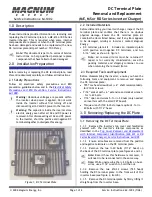
Reference Oscillator
R&S
®
SMA100B
176
User Manual 1178.3834.02 ─ 03
●
Interfered or noisy external reference signal
(see
"Deriving 10 MHz form the external reference frequency"
●
1 GHz reference coupling
for phase coherence of the RF signals with reasonable
long-term phase stability
(see
"Sharing the 1 GHz reference frequency to obtain phase-coherent signals"
Connectors overview
Use the "Show Connector" function to indicate the connector on the front/real panel:
●
●
●
Distributing the internal 10 MHz reference signal to further instruments
The internal reference oscillator provides the reference frequency:
●
Internal f
ref
= 10 MHz (10 MHz at connector REF OUT)
●
= "Internal"
●
Reference Output/1GHz Reference Output
= "10 MHz"
●
Optional:
–
= "On"
–
Figure 7-1: Synchronizing instruments using the internal 10 MHz reference signal of the
R&S
SMA100B
EFC
= External frequency control
EFC,REF IN,REF OUT = Connectors
In phase noise measurement systems, for example, you can additionally use the EFC
(external frequency control) function and shift the frequency.
EFC is a function that transforms an external tuning voltage into frequency shift, where
the value range of the resulting frequency is a technical characteristic listed in the data
sheet. See the data sheet also for information on the sensitivity, input voltage range,
impedance and maximum bandwidth for external tuning signal.
Consider the following interdependency:
●
EFC in combination with an external PLL
If the EFC is applied in combination with an external PLL (phase locked loop), the
PLL bandwidth must be smaller than the bandwidth of the external tuning signal.
●
FM-DC mode
Using the Reference Frequency for Instruments Synchronization















































